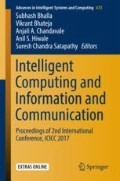Abstract
Node centrality is one of the integral measures in network analysis with wide range of applications from socioeconomic to personalized recommendation. We argue that an effective centrality measure should undertake stability even under information loss or noise introduced in the network. With six local information-based centrality metric, we investigate the effect of varying assortativity while keeping degree distribution unchanged, using networks with scale free and exponential degree distribution. This model provides a novel scope to analyze the stability of centrality metric which can further find many applications in social science, biology, information science, community detection and so on.
Access this chapter
Tax calculation will be finalised at checkout
Purchases are for personal use only
References
Guimera, R., Mossa, S., Turtschi, A., & Amaral, L. N.: The worldwide air transportation network: Anomalous centrality, community structure, and cities’ global roles. Proceedings of the National Academy of Sciences, 102(22), 7794–7799 (2005).
Jeong, H., Mason, S. P., Barabási, A. L., & Oltvai, Z. N.: Lethality and centrality in protein networks. Nature, 411(6833), 41–42 (2001).
Lamberti, F., Sanna, A., & Demartini, C.: A relation-based page rank algorithm for semantic web search engines. IEEE Transactions on Knowledge and Data Engineering, 21(1), 123–136 (2009).
Malliaros, F. D., Rossi, M. E. G., & Vazirgiannis, M.: Locating influential nodes in complex networks. Scientific reports, 6 (2016).
Strogatz, S. H.: Exploring complex networks. Nature, 410(6825), 268–276 (2001).
Borge-Holthoefer, J., Rivero, A., García, I., Cauhé, E., Ferrer, A., Ferrer, D., & Sanz, F.: Structural and dynamical patterns on online social networks: the spanish may 15th movement as a case study. PloS one, 6(8), e23883 (2011).
Barthelemy, M., Barrat, A., & Vespignani, A.: Dynamical processes on complex networks (2008).
Hirsch, J. E.: An index to quantify an individual’s scientific research output. Proceedings of the National academy of Sciences of the United States of America, 16569–16572 (2005).
Joyce, K. E., Laurienti, P. J., Burdette, J. H., & Hayasaka, S.: A new measure of centrality for brain networks. PLoS One, 5(8), e12200 (2010).
Q. Zhang, M. Li, Y. Du, Y. Deng, “Local structure entropy of complex networks”, arXiv preprint arXiv:1412.3910. 2014 December.
Zhang, Q., Li, M., Du, Y., & Deng, Y. Local structure entropy of complex networks. arXiv preprint arXiv:1412.3910 (2014).
Xu, J., & Li, Y.: Discovering disease-genes by topological features in human protein–protein interaction network. Bioinformatics, 22(22), 2800–2805(2006).
Li, M., Wang, J., Chen, X., Wang, H., & Pan, Y.: A local average connectivity-based method for identifying essential proteins from the network level. Computational Biology and Chemistry, 35(3), 143–150 (2011).
Lempel, R., & Moran, S.: Rank-stability and rank-similarity of link-based web ranking algorithms in authority-connected graphs. Information Retrieval, 8(2), 245–264 (2005).
de Kerchove, C., Ninove, L., & Van Dooren, P.: Maximizing PageRank via outlinks. Linear Algebra and its Applications, 429(5–6), 1254–1276 (2008).
Senanayake, U., Szot, P., Piraveenan, M., & Kasthurirathna, D.: The performance of page rank algorithm under degree preserving perturbations. In Foundations of Computational Intelligence (FOCI), 2014 IEEE Symposium on (pp. 24–29). IEEE (2014, December).
Ng, A. Y., Zheng, A. X., & Jordan, M. I.: Link analysis, eigenvectors and stability. In International Joint Conference on Artificial Intelligence (Vol. 17, No. 1, pp. 903–910). LAWRENCE ERLBAUM ASSOCIATES LTD (2001, August).
Ghoshal, G., & Barabási, A. L.: Ranking stability and super-stable nodes in complex networks. Nature Communications, 2, 394 (2011).
Sarkar, S., Kumar, S., Bhowmick, S., & Mukherjee, A.: Sensitivity and reliability in incomplete networks: Centrality metrics to community scoring functions. In Advances in Social Networks Analysis and Mining (ASONAM), 2016 IEEE/ACM International Conference on (pp. 69–72). IEEE (2016, August).
Gower, J. C.: Similarity, dissimilarity, and distance measure. Encyclopedia of Biostatistics (2005).
Yang, R.: Adjusting assortativity in complex networks. In Proceedings of the 2014 ACM Southeast Regional Conference (p. 2). ACM (2014, March).
Author information
Authors and Affiliations
Corresponding author
Editor information
Editors and Affiliations
Rights and permissions
Copyright information
© 2018 Springer Nature Singapore Pte Ltd.
About this paper
Cite this paper
Saxena, C., Doja, M.N., Ahmad, T. (2018). Stability of Local Information-Based Centrality Measurements Under Degree Preserving Randomizations. In: Bhalla, S., Bhateja, V., Chandavale, A., Hiwale, A., Satapathy, S. (eds) Intelligent Computing and Information and Communication. Advances in Intelligent Systems and Computing, vol 673. Springer, Singapore. https://doi.org/10.1007/978-981-10-7245-1_39
Download citation
DOI: https://doi.org/10.1007/978-981-10-7245-1_39
Published:
Publisher Name: Springer, Singapore
Print ISBN: 978-981-10-7244-4
Online ISBN: 978-981-10-7245-1
eBook Packages: EngineeringEngineering (R0)

